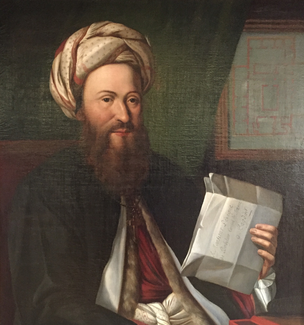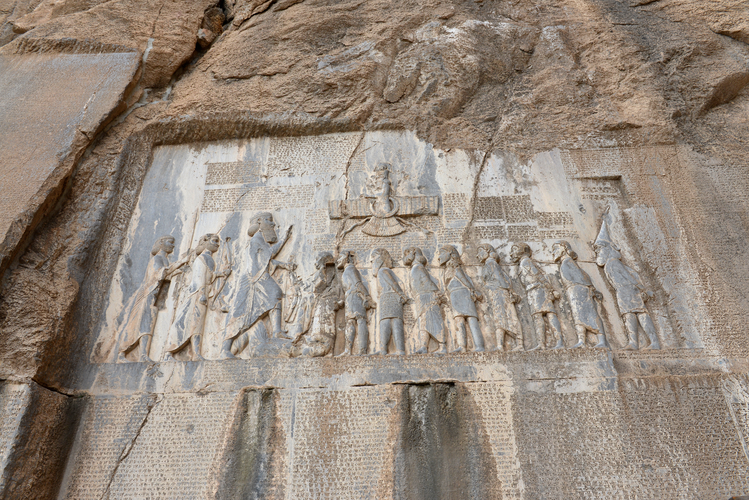Faculty Focus
This article first appeared in ISAW Newsletter 19, Fall 2017.
From myth to history: Jean-Claude Ballyet, the French Enlightenment and Bisotun
Daniel T Potts
Professor of Ancient Near Eastern Archaeology and History
The rock-cut monument at Bisotun in western Iran holds a special place in the history of ancient Near Eastern studies. The trilingual inscriptions there — in Babylonian, Old Persian and Elamite — played an important role in the decipherment of cuneiform. Both the texts and the associated image constitute a primary source on the ascension of Darius I to power.
 Portrait of Jean-Claude Ballyet by an unknown artist in the Hôtel de Ville, Marnay, showing Ballyet holding a letter addressed to ‘Monsieur l’évêque de Babilone, consul de France à Baghdad.’ Behind him is the plan of the church of Morteau, of which he was made Prior in 1752
But what was the significance of Bisotun before Sir Henry Creswicke Rawlinson began publishing its inscriptions in 1848? A ‘Western’ view appears in the work of Diodorus Siculus who attributed the monument, ‘at the mountain known as Bagistanon,’ to the mythical Assyrian queen Semiramis (Library of History 2. 13.1-2). Running right through Persian literature, embodied most famously in Nizami’s poem Xosrow and Shirin, the ‘Eastern’ view attributed the carving at Bisotun to Farhad, the tragic lover of Shirin, wife of the Sasanian emperor Xosrow II (570-628 AD).
Portrait of Jean-Claude Ballyet by an unknown artist in the Hôtel de Ville, Marnay, showing Ballyet holding a letter addressed to ‘Monsieur l’évêque de Babilone, consul de France à Baghdad.’ Behind him is the plan of the church of Morteau, of which he was made Prior in 1752
But what was the significance of Bisotun before Sir Henry Creswicke Rawlinson began publishing its inscriptions in 1848? A ‘Western’ view appears in the work of Diodorus Siculus who attributed the monument, ‘at the mountain known as Bagistanon,’ to the mythical Assyrian queen Semiramis (Library of History 2. 13.1-2). Running right through Persian literature, embodied most famously in Nizami’s poem Xosrow and Shirin, the ‘Eastern’ view attributed the carving at Bisotun to Farhad, the tragic lover of Shirin, wife of the Sasanian emperor Xosrow II (570-628 AD).
Perhaps the first attempt to replace this folkloric or mythic explanation with an historical one appeared in a paper entitled ‘Mémoire sur un Monument très-ancien sculpté dans une montagne de la Médie’ (Memoir on a very ancient monument sculpted into a mountain in Media) which was delivered in 1755 at the Académie royale des Inscriptions et Belles-Lettres in Paris by Jean-Baptiste Bourguignon d’Anville (1697-1782). D’Anville attributed his information on Bisotun, which he never visited, to an unpublished report written by Father Emmanuel de Saint-Albert, a Decalced (‘barefoot’) Carmelite monk (Carme déchaussé) and Vicar-Apostolic in Baghdad; who gave it to ‘Monsieur Bellet,’ medical doctor in Constantinople; who sent it to the Duke d’Orléans in Paris; who passed it on in 1743 to d’Anville, a man who combined the offices of Secrétaire ordinaire of the Duke and tutor of his son, Louis Philippe I, with being premier Géographe du Roi, in this case, Louis XV.
I came across this intriguing example of the Enlightenment ‘republic of letters’ in action while tracking down a completely unrelated piece of information contained in Bourguignon d’Anville’s paper. Although the many maps and writings of this great cartographer are well-known, as is the scholarly patronage of Louis, Duke d’Orléans (1703-1752), the other two names in this story —Emmanuel de Saint-Albert and ‘Monsieur Bellet’ — are not. Emmanuel de Saint-Albert was the ‘nom de religion’ of Jean-Claude Ballyet (1702-1773). Born in Marnay (diocese of Besançon), France, he was appointed Pro-Vicar of Baghdad in 1728 by Pope Benedict XIII; named ‘consul of the French nation’ in Baghdad by Louis XV in 1741; and consecrated Bishop of Babylon in 1743. He died of the plague in Baghdad in 1773.
Assyriologists and archaeologists may have seen his name in connection with the early identification of the ancient site of Babylon, but since the French Orientalist Sylvestre de Sacy published his Mémoires sur diverse Antiquités de la Perse in 1793, Ballyet’s important observations on Bisotun which, among other things, cast doubt on any Sasanian association, mediated via the story of Farhad and Shirin, have been largely ignored. Ballyet had two opportunities to visit Bisotun: between November, 1729, and May, 730, and again between May and August 1735, when he lived in Hamadan. He also made detailed observations on the Sasanian reliefs at Taq-e Bostan. Edward Ives, an English surgeon, who met Ballyet in Baghdad in 1758, reported a lively account given to him by the Carmelite of the site ‘wherein is a great deal of sculpture in marble, with Basso and Alto Relieves, representing battles, trophies, arms, men, and camels; and one most remarkable horse whose body seems quite detached from the wall.’
Isaac Bellet (1693-1780) is equally intriguing. Appointed one of many royal doctors to Louis XV in 1737, he undertook secret negotiations for France in Constantinople one year later. Known in psychological and medical circles for his provocative treatise Lettres sur le pouvoir de l’imagination des femmes enceintes (Letters on the force of the imagination in pregnant women, 1745), he was a member of the Academy of Sciences of Bordeaux and also served as Inspector General of Mineral Waters in France. With such a background, one would not necessarily expect to find an expert on matters ancient Near Eastern, yet one of his letters to the Duke d’Orléans sent from Constantinople reveals that he had received instructions from d’Anville to investigate certain geographical matters, as well as a map which he showed to a Georgian interpreter who was familiar with some of the placenames in which d’Anville took an interest. The work of Ballyet and Bellet truly exemplifies the republic of letters that characterized the intellectually vibrant atmosphere of the mid-18th century and shows us, yet again, that many topics of interest to us today were already being actively investigated by our Enlightenment predecessors.
